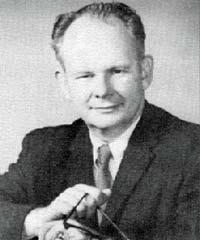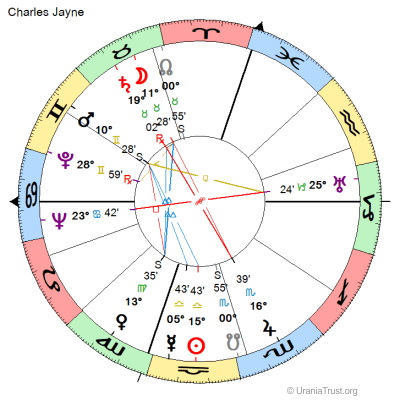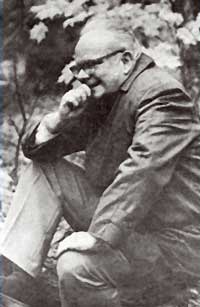 Charles A. Jayne, Jr.
Charles A. Jayne, Jr.9 October 1911, 10:43 PM
Jenkintown, PA, USA
Placidus Houses, True Node
Geocentric, Tropical
(Source Notes)

Charles A. Jayne, Jr. was born on October 9, 1911 at 10:39 am in Jenkintown, Pa. He was educated at Princeton University (philosophy), Virginia Polytechnic Institute (electrical engineering), and Columbia University (psychology), and the Asia Institute. He was a technical analyst on Wall Street from 1961 to 1969, and was mentioned very favorably by James Dines in his book about technical stock market analysis. Well schooled in theosophy, he was vice-president of Nicholas DeVore's Astrological Research Society. He was president of the Astrologers' Guild of America (1958-60) and founded Astrological Research Associates in 1958. He and his wife, Vivia Jayne, edited the magazine In Search from 1958 to 1962, an international astrological journal. In 1970 he founded the Association for Research in Cosmecology, an organization specializing in the reintegration of astrology into mainline science. Jayne wrote the mundane astrology column in Dell Horoscope for about 15 years. He was also one of the founders of the National Council for Geocosmic Research. He was a recipient of the Marc Edmund Jones Award.
Charles used to say that that one needed to study astronomy in order to truly understand astrology. He was interested in the astronomical structure of astrology. Astronomy was the physical side of the spiritual. He believed that the spiritual world is reflected in the physical. Charles felt that the physical universe is but the shadow of God. He blended technical proficiency (he did not spare words when he saw inaccurate work) with spiritual insight. The stars were intense generators of pure energy, and the planets were step-down transformers that enabled humans to tap into the energy.
Jayne and Johndro
Charles Jayne was my teacher and friend for 12 years. His greatest accomplishments are largely unknown. He studied eclipses and their paths for 15 years and had developed a working system of mundane astrology by the early 1940s. His work and his outlook was very much guided by Lorne Edward Johndro of California, another one of the great astrologers of the last century. I have found that it is more important to understand the approach developed by both men. Johndro worked with Cleveland astrologer Ken Brown. Jayne and Johndro corresponded, but never met. Curiously, upon Johndro's death, Brown began the eulogy, but he passed away during this task, leaving the completion to Charles. Many of Jayne's concepts were based upon Johndro's ideas. Brown once said: "This discovery, made by Jayne, was only possible because of Johndro's work."
Predictive Work
Both Johndro and Jayne had the same view of predictive astrology. They both believed that there was a very precise planetary configuration that described every event. I think that both would agree that it was possible to predict minor events on a day-day basis, such as Uncle Harvey going to the den at 4:15 pm to clean his pipe. This would be a remarkable exercise in predictive work, but it would be like spending $10 to get $9 worth of information. They were opposed to the thought that an event was caused by last week's Saturn hit or next week's Uranus transit. They disapproved of this thought that the former's influence lagged while the latter's led. Thus, they developed new forecasting methods to pick up where conventional tools left off.
When I was a student, I asked Charles Jayne to look at my chart because I was having a difficult time. He set his 086 Commodore computer running. Page after page of hits ran off. I finally asked what he was running. Here was the list:
- Transits
- Secondary Progressions
- Solar Arc Directions
- Ascendant Arc Directions (Difference between the natal and progressed ascendant)
- Vertex Arc Directions (Difference between the natal and progressed vertex)
- Declination Arcs (Difference between the declination of the natal and the progressed Sun)
All arcs and progressions were run both direct and converse by half, whole, and double arc. Needless to say, there were lots of exact hits every day. I protested, and he told me to shut up. He then proceeded to clearly delineate anything of any importance that had happened to me in the previous three weeks, to the day. He then said, "You see, Bill, everything in astrology works. You just have to know what tool to use to answer the question at hand at any one time."
The techniques of ascendant, vertex, and declination arcs were developed to describe events that could not be explained by known predictive techniques. Most conventional hits are too weak to be considered. He pointed to the progressed Moon as an example, saying that the effect lasted 1 to 3 days, unless other factors were involved. As far as secondary progressions go, he felt that there were two that were major. First was an eclipse by secondary progression. If you were born 10 days before an eclipse, then you would experience an eclipse by progression in the 10th year of life. Second was the exact progression of two outer planets. If one is born with an inexact aspect between two outer planets, then the year in which they progress to an exact aspect will be vital. He reckoned that there were only 4 or 5 of these in a lifetime. The message here is that there is value in all predictive techniques if they are interpreted in the proper context.
Techniques for Any Situation
 Charles Jayne
Charles JayneHis work with unknown planets is remarkable. I was with him on the day when he rectified a chart by placing Midas (windfall material gains) on the ascendant. It turned out that the lady client had received much real estate in a divorce settlement.
He taught that all astrological techniques worked. It was up to the astrologer to reach into the bag of tricks for the tool needed to answer the client's question. He also advised that to be the best astrologer, one should study astronomy. He guided me into using declination, right ascension, helio, speed, distance, etc. in my work. These tools have been very useful in financial astrology. He once explained that heliocentric nodes were different from geocentric nodes. Both were real; they simply had different meanings. He did not reject one for the other; he accepted both.
The Vertex
Jayne once received a letter from Johndro explaining his work with the newly-developed electrical ascendant. Jayne tested this new point by running solar arcs to it. He concluded that the opposite point in the zodiac was more sensitive. Johndro followed this conclusion with more testing and found Jayne's finding to be accurate. Today, we know this point as the vertex. Jayne felt that this point was fated and represented matters beyond our control.
The discovery of the vertex was based upon his GEM dynamic field theory where G stands for gravity, E for electrical, and M for magnetism. The meridian and the midheaven correlated to gravity, the electrical ascendant (antivertex-vertex axis) to electricity, and the ascendant and horizon to magnetism.
Eclipse Work
Charles worked on eclipses for 50 years. Much of my knowledge of this subject derives from his work. He discovered that the shadow of the eclipse embodies or holds the nature of the horoscope of that eclipse. He also discovered that past paths can be activated by current eclipses. Writing in Dell Horoscope in the 1940s, he accurately predicted a good deal of the course of WW2. This includes the break between Germany and the USSR and the time and the location of the US victory at the Battle of the Coral Sea. Before his passing, he forecasted the breakup of the USSR by 1989-1990.
His basic eclipse rules were:
The rule of thumb was that a solar eclipse could have an effect beginning at least 3 months before the phenomena, lasting for 6 months or at least until the next solar eclipse.
Events occurring near eclipses are always memorable. They tend to add energy to any activity that takes place near them. These events take on more importance than the same type of event that occurs distant from an eclipse. There is a sharp difference between the week before and the week after the eclipse. Any event or undertaking begun in the week prior to a solar eclipse differs from those actions taken after the eclipse in that they are very fated. That is, it works out unexpectedly. Events before and after the eclipse are important, but the events occurring before the eclipse take on the added attribute of being unpredictable. It is best to postpone major decisions until the week following an eclipse because one usually obtains new information or awareness that causes one to make a different decision. The eclipse is a red flag indicating that there is hidden knowledge that can upset one's plans.
Affairs begin and end abruptly around eclipses. There is a sudden focus, and then the emphasis terminates as abruptly as it began. Lunar eclipses are less powerful, but they have the same character. Eclipses can mark changes in phase in one's life. These events may be initiations or terminations. There can be sharp and dramatic changes in one's status and prestige. Public standing may soar or crash due to the effects of an eclipse.
One of the Great Astrologers of the Last Century
He was a master of rectification, practicing for over 50 years. He once said that one could become an excellent astrologer by accurately rectifying 50 horoscopes. Charles believed that all horoscopes should be rectified. He and Eleanor Heseltine rectified batches of horoscopes and concluded that solar arc and declination arc were the most accurate techniques for doing so.
His rejection of psychological astrology was a reflection of his own preference for the more mental side of the field. During a period when astrology was becoming more humanistic and psychological, Charles provided a balance in that he constantly taught the need for accuracy and technical expertise.
Jayne's book on progressions and directions is still a landmark work. His work on locality astrology, long-term cycles, and pre-natal charts was ground breaking. Having studied history, he confirmed in astrological terms many of the cycles discovered by academics like Toynbee. This was the tool that was employed to predict the fall of the Soviet empire.
Charles Jayne is the father of modern technical astrology based upon his 57 years of work. The fact that he did his work in a period that had no PCs and no software makes his accomplishments all the more remarkable.
Jayne's books are available from the American Federation of Astrologers, 6535 S. Rural Rd. Tempe, AZ 85282-0901, USA.
Cycles Research has begun to re-publish his In Search magazine (billmeridian.com).
